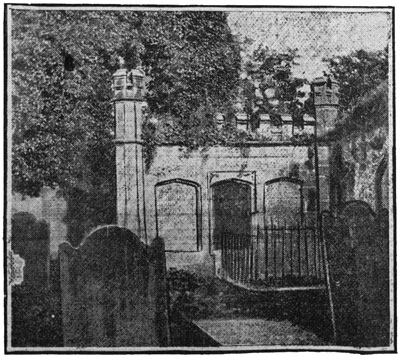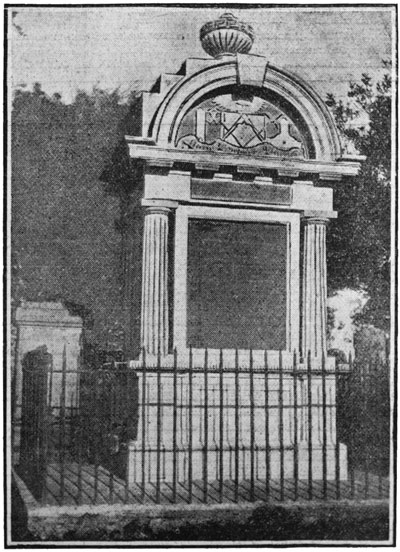Belfast Evening Telegraph, Saturday, November 24, 1906
V -- Templecorran, Ballycarry
Very few of the visitors to Islandmagee ever think of turning their footsteps towards the interior of the country. They all make for the coast, and it may be that the clumsy hill in the immediate foreground deters many of them from exploring in that direction. The long range of verdant hill dips gracefully at this point as if the weight of the little villages on the top had proved too heavy a burden for the broad back of the mountain. Standing out prominently and silhouetted against the sky is the spire of Templecorran Church. This church occupies an historic spot, and within the confines of the old churchyard there are many interesting mementoes of a byegone age. There is still standing part of the walls of the old edifice with which Dean Swift was so prominently identified, but the story of the clever satirist has been too well told to even bear re-telling. Here we can look round and conjure up memories of "The Take of the Tub," "The Battle of the Books," and wonder at his several infatuations, which were afterwards immortalised in "Stella," "Vanessa," &c.

Interior of the ruins of Dean Swift's old Church at Templecorran
He, however, is not the only representative of literature which this hallowed ground can claim connection with. You will scarcely have clambered over the quaint old stone stile until you will be pulled up by a rather dignified memorial which has been erected to the memory of James Orr, the Bard of Ballycarry, who, if only for "The Irishman," has a right to a place in our hearts.
I photographed the side of the monument, which bears the particulars of the subscribers and sets forth all the virtues of this poet, patriot and philanthropist.
The other side of the monument bears the peculiar coupled --
"When lost amang nettles ye'll find if ye search,
My stane o' remembrance is mark'd wi' an arch."
after which
Sacred to the Memory
of
JAMES ORR
The Bard of Ballycarry
Obiit 24 April 1816 AE 46
and below this is a long person by Orr's biographer. A. MacDowell, of which the first and last verse will suffice:-
"While truth and right bless Erin's plains,
Or freedom's sons her standard rear,
Or while they spurn at slav'ry's chains,
The name of Orr they shall revere."
"Near Templecorran's ruined fane
(That with the wild blast nods) he lies
Where solitude and silence reign,
Till the last trump shall bid him rise."
Orr was not the first poet to suffer for his indiscretions, but he found it advisable to leave the country for a time during the rebellion of '98. However, he returned to his work as a weaver, but continued manufacturing verse, while he wove linen. Ballycarry seems to have been an unsafe place during those troublous times which marked the closing of the 18th century, for in another part of this same burying-ground we find a very modest record of one who did not escape the penalty. It is engraved on an ordinary stone. There is a small list of good folk who have lived and died in peace, but the last of the roll is described as follows:--
And WILLIAM
who died June 30th
1798 aged 16 years.
The Ballycarry Martyr.

Monument to James Orr, the Bard of Ballycarry
Those who preceded him on the list died much more recently, so that his name has only been added as a sort of afterthought; but what visions it conjures up? No details are given, but it is said he was dealt with summarily, and executed for some trifling offence in those days when life was cheap.
It is related that on 7th June, 1798, when he was only 15 or 16 years of age, be commandeered one of the horses belonging to Mr. Kerr and galloped off through Islandmagee to "raise the country," came back, put in the first horse, and took out a second on which he rode off to Donegore. He was hung on the cleft of a sycamore tree, which grew near his widowed mother's house. Some time after the people of Larne came out at night and cut down this tree to take away the sight of it from his poor mother.
There is a stone recording a death over, a hundred years previous to this. The inscription is almost obliterated, but as far as I could make out it runs:-
Here lyeth the
Body of Will Steel
who deceased the
15 of April 168--
The last figure is quite gone, but the late Mr. Steel was 57 years of age when he died so long ago. Not far away lies the body of Robert Giles, who departed this life on April 22, 1770, aged 78 years, and he had for a near neighbour one who was deemed worthy of more than the ordinary share of epitaph.
Here lyeth the body of
THOMAS McCLEE
RY who departed this life
Decr ye 20th 1778 after
living in Peace and Unan-
amity 84 years with his br
ethern of Men which we
hope will be manifested by
the LORD of HOSTS.
The sculptor had evidently trusted to luck in working out the inscription, and many of the words are divided awkwardly, but one thing to notice particularly is the ages to which these ancients lived. It is probably that nowhere in the North of Ireland will you find such a collection of veterans in one enclosure that you can in Ballycarry. Why, only recently was buried here Ann Penny 102 years of age, and every storm almost testifies eloquently to the longevity of the natives. This tenacity is not confined to one period, but is evidently a characteristic of the district.
In the middle of the yard and close to Orr's monumental there is a dark, flat stone, which carries a history in its inscription:--
To
The Memory of
RICHARD O PREY
Etat 22
who was unfortunately drowned
on the night of Tuesday the 15th Decr
1817
together with four others who perished
by the fatal accident of their boat upsetting
in a squall when endeavouring to reach
the Dalriada
As the least commendation to posterity
of a character so worthy and amiable
in his station
it may be truly averred that he
was an honest sober faithful and
most attached servant
This stone
in commemoration of
the melancholy event
was erected
immediately subsequent to his
premature death by order of the
EARL of BELFAST
as a memorial of his regard and esteem
Also his father
NICHOLAS O PREY
Who died the 25th Augt 1835 aged 86 years
And MARY his wife who died on 19th of
August, 1857.
Inscribed by his wife ELIZA O PREY.
The care in drafting the inscription seems to have departed with the noble earl, and one would have difficulty in sorting out the relations of the last two or three. Besides, which it would be interesting to know if they were entitled to claim aN the virtues set forth, for the unfortunate youth.
But there is one little monument which might well escape the observation of most people. It is on the side facing Muldersleigh -- a small piece of slate cemented to a background of stone, and almost hidden beneath a young tree. It was prepared by the owner himself in readiness for his death and bears the year of his birth without any record of when he died. There is a crudely drawn compass and square and cross swords, with the simple inscription scratched on the slate --
JAMES BURNS
Born 1775
and below he has indulged in a little literary puzzle which must have agitated the minds of his contemporaries. I give it as it appears:-
Christ 61s th2 64rd thIt sp1K2 3t
H2 t44k th2 br21d 1nd br2Kk 3t
2nd 6h1t th1t 64rd d3d m1k2 3t
Th1t 5 b2li2v2 1nd t1k2 3t
and the people living in the locality even to this day preserve translations of the mystic message; but, with all the messages of modern science at their command, the epigraphical will have no difficulty in tracing that the deceased James has used the figures 1, 2, 3, 4, 5, 6 for the vowels A, E, I, O, U, W, and the translation is:-
Christ, was the word that spake it
He took the bread and break it
And what that word did make it
That you believe and take it.
This James Burns was a Croppy of '98, and his history has been recorded very fully by Mr. Young in his interesting little volume "Ulster in '98." He fought at Antrim, and actually handled and helped to load the single brass six-pounder gun with which the insurgents hoped to capture the town. He also joined in the flight, and he, in company with a comrade, succeeded in killing two dragoons who pursued them. He had a most remarkable career and his wanderings are certainly worthy more than passing attention. There are many other interesting stones, especially inside the old church ruins. Not only do some of them give (in an uncertain fashion) the location of the remains, but they give a brief history of the descendants. Here is a sample:--
NEAR THIS LYETH THE BODY OF
THAT FAITHFUL & EMENENT SER-
VANT OF GOD Mr EDWARD BRICE WHO
BEGUN PREACHING OF THE GOSPELE
IN THIS PARISH 1613 CONTINUEING
WITH QUIET SUCCESS WHILE 1630
IN Wh HE DYED AGED 67 & LEFT
TWO SONS & TWO DAUGHTERS
HIS SON ROBERT BRICE ESQ AF
TER ACQVIREING A FORTVNE DYED
IN DVBLIN 22 OF NOVbr 1676
AGED 63 & LEFT 3 SONS & DAUGHTERS.
HIS ELDEST SON RONDAL
BRICE ESQr DYED IN DUBLIN A MEM
BER OF PARLIAMENT FOR LISBYRNE
8th OF SEPbr 1697 AGED 54 & LEFT
TWO SONS & TWO DAUGHTERS.
I felt that I had spent a most interesting afternoon in this "Silent Land" as I clambered back again over the old stile, and saw the Scotch coast basking in the slanting sun rays. The little village was almost as quiet as the churchyard as I wandered slowly down the hill and joined the boisterous trippers who had found their happiness in the opposite direction.

